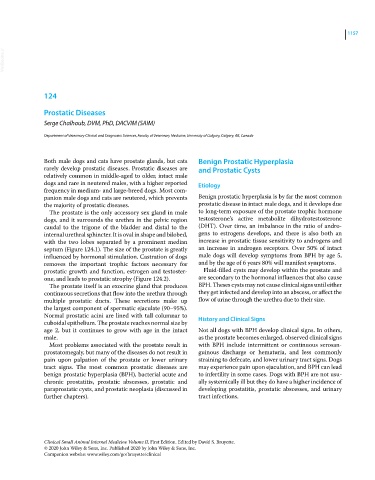Page 1219 - Clinical Small Animal Internal Medicine
P. 1219
1157
VetBooks.ir
124
Prostatic Diseases
Serge Chalhoub, DVM, PhD, DACVIM (SAIM)
Department of Veterinary Clinical and Diagnostic Sciences, Faculty of Veterinary Medicine, University of Calgary, Calgary, AB, Canada
Both male dogs and cats have prostate glands, but cats Benign Prostatic Hyperplasia
rarely develop prostatic diseases. Prostatic diseases are and Prostatic Cysts
relatively common in middle‐aged to older, intact male
dogs and rare in neutered males, with a higher reported Etiology
frequency in medium‐ and large‐breed dogs. Most com-
panion male dogs and cats are neutered, which prevents Benign prostatic hyperplasia is by far the most common
the majority of prostatic diseases. prostatic disease in intact male dogs, and it develops due
The prostate is the only accessory sex gland in male to long‐term exposure of the prostate trophic hormone
dogs, and it surrounds the urethra in the pelvic region testosterone’s active metabolite dihydrotestosterone
caudal to the trigone of the bladder and distal to the (DHT). Over time, an imbalance in the ratio of andro-
internal urethral sphincter. It is oval in shape and bilobed, gens to estrogens develops, and there is also both an
with the two lobes separated by a prominent median increase in prostatic tissue sensitivity to androgens and
septum (Figure 124.1). The size of the prostate is greatly an increase in androgen receptors. Over 50% of intact
influenced by hormonal stimulation. Castration of dogs male dogs will develop symptoms from BPH by age 5,
removes the important trophic factors necessary for and by the age of 6 years 80% will manifest symptoms.
prostatic growth and function, estrogen and testoster- Fluid‐filled cysts may develop within the prostate and
one, and leads to prostatic atrophy (Figure 124.2). are secondary to the hormonal influences that also cause
The prostate itself is an exocrine gland that produces BPH. Theses cysts may not cause clinical signs until either
continuous secretions that flow into the urethra through they get infected and develop into an abscess, or affect the
multiple prostatic ducts. These secretions make up flow of urine through the urethra due to their size.
the largest component of spermatic ejaculate (90–95%).
Normal prostatic acini are lined with tall columnar to History and Clinical Signs
cuboidal epithelium. The prostate reaches normal size by
age 2, but it continues to grow with age in the intact Not all dogs with BPH develop clinical signs. In others,
male. as the prostate becomes enlarged, observed clinical signs
Most problems associated with the prostate result in with BPH include intermittent or continuous serosan-
prostatomegaly, but many of the diseases do not result in guinous discharge or hematuria, and less commonly
pain upon palpation of the prostate or lower urinary straining to defecate, and lower urinary tract signs. Dogs
tract signs. The most common prostatic diseases are may experience pain upon ejaculation, and BPH can lead
benign prostatic hyperplasia (BPH), bacterial acute and to infertility in some cases. Dogs with BPH are not usu-
chronic prostatitis, prostatic abscesses, prostatic and ally systemically ill but they do have a higher incidence of
paraprostatic cysts, and prostatic neoplasia (discussed in developing prostatitis, prostatic abscesses, and urinary
further chapters). tract infections.
Clinical Small Animal Internal Medicine Volume II, First Edition. Edited by David S. Bruyette.
© 2020 John Wiley & Sons, Inc. Published 2020 by John Wiley & Sons, Inc.
Companion website: www.wiley.com/go/bruyette/clinical

